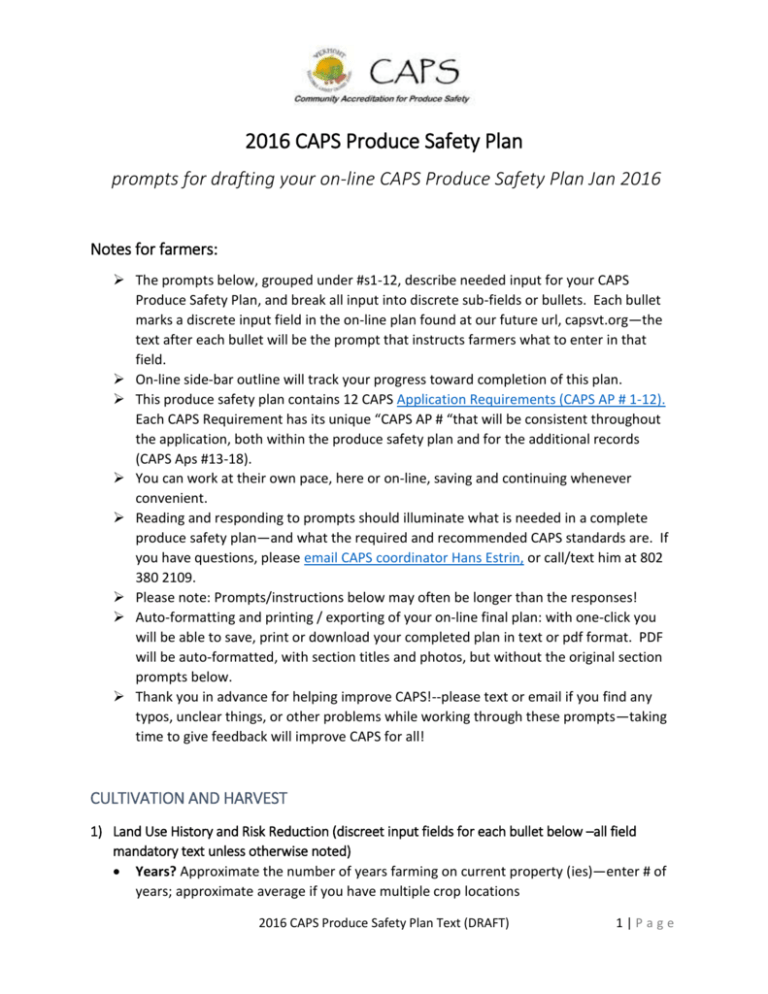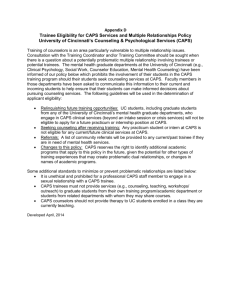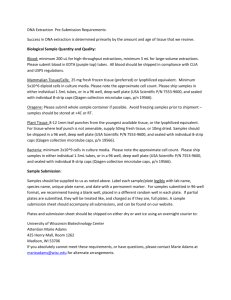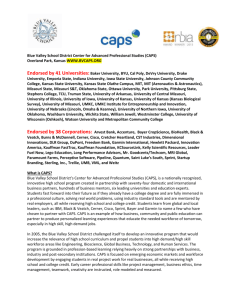2016 CAPS Produce Safety Plan prompts
advertisement

2016 CAPS Produce Safety Plan prompts for drafting your on-line CAPS Produce Safety Plan Jan 2016 Notes for farmers: The prompts below, grouped under #s1-12, describe needed input for your CAPS Produce Safety Plan, and break all input into discrete sub-fields or bullets. Each bullet marks a discrete input field in the on-line plan found at our future url, capsvt.org—the text after each bullet will be the prompt that instructs farmers what to enter in that field. On-line side-bar outline will track your progress toward completion of this plan. This produce safety plan contains 12 CAPS Application Requirements (CAPS AP # 1-12). Each CAPS Requirement has its unique “CAPS AP # “that will be consistent throughout the application, both within the produce safety plan and for the additional records (CAPS Aps #13-18). You can work at their own pace, here or on-line, saving and continuing whenever convenient. Reading and responding to prompts should illuminate what is needed in a complete produce safety plan—and what the required and recommended CAPS standards are. If you have questions, please email CAPS coordinator Hans Estrin, or call/text him at 802 380 2109. Please note: Prompts/instructions below may often be longer than the responses! Auto-formatting and printing / exporting of your on-line final plan: with one-click you will be able to save, print or download your completed plan in text or pdf format. PDF will be auto-formatted, with section titles and photos, but without the original section prompts below. Thank you in advance for helping improve CAPS!--please text or email if you find any typos, unclear things, or other problems while working through these prompts—taking time to give feedback will improve CAPS for all! CULTIVATION AND HARVEST 1) Land Use History and Risk Reduction (discreet input fields for each bullet below –all field mandatory text unless otherwise noted) Years? Approximate the number of years farming on current property (ies)—enter # of years; approximate average if you have multiple crop locations 2016 CAPS Produce Safety Plan Text (DRAFT) 1|Page Acres? Approximate your current number of acres in edible crop production (enter # of Acres) Major Crops?--List a few (up to 10) of your major crops or crop types (text) Potential Risk?--List and briefly describe any known / existing potential food safety risks that could impact your production fields (List could include: flood risk, manure pile runoff, dump, livestock burial, adjacent livestock grazing, stockyard, or failed /old septic systems). Enter “No risks known” if you can think of nothing. (text) Potential Risk Reduction? —For each risk listed above, briefly describe WHAT YOU DO or WOULD DO to deduce or minimize the potential for contamination. (Examples could include: flood response plan, vegetative buffers, down-slope positioning of manure piles, low-risk crop planting near contamination source, soil test for historic dumps sites, outbuildings with lead paint that could get into product (if on ceiling) etc.) Do you have livestock on your farm?—answer yes / no, If you answer yes, respond to the next two prompts about cross-contamination, otherwise, leave them blank: Livestock description—Livestock are an integral and healthy part of our small diversified farming community. And for farms with livestock, cross-contamination between animal manure and produce is a significant food safety risk. Describe your livestock operation (e.g. type(s), location(s), and head number(s)) Livestock Cross-contamination risk—describe, in your opinion, the most significant sources of cross-contamination risk (e.g. employees completing chicken chores and then harvesting) Livestock cross-contamination risk reduction— The general mitigation strategy is to keep raw manure and produce separate. Specific strategies may include dedicated boots and coveralls for animal chores, hand washing, dedicated livestock and produce jobs, buffers, and spraying-off tractor tires to avoid obvious contamination of produce staging area. For each of the sources mentioned above, describe how you minimize or mitigate this risk. Farm Map-- Add a photo or pdf of your farm map below. The map can be a hand-drawn sketch, computer generated, an NRCS map, or a combination of google earth and labels. Warning to perfectionists: It doesn’t not have to be fancy or even professional-looking! The point of this map is to show the general layout of your farm and the location of potential risks and any other items relevant to food safety. A complete map will contain: A Map Title with Farm Name and Date Legible hand-drawn or satellite base-map showing farm and risk-relevant production fields, with an approximate scale with a north arrow. a key or notation showing location of relevant food safety items like: pack house, bathroom(s), septic, well-heads, pasture, animal barns, barnyards, first aid kit(s), flood prone fields, and other potential risks that you identified above. o Notes—Remote fields with no identified risks need not be included; include multiple maps for remote fields with potential risk(s); ; Production 2016 CAPS Produce Safety Plan Text (DRAFT) 2|Page fields should be ¼ -mile from bathrooms, or <5 minute drive in a farm vehicle. o Contact hestrin@uvm.edu to request a high-quality google earth screen shot to use as a base-map of your farm—you will need to add labels. Or your NRCS agent 2) Manure and Compost Overview (discreet input fields for each bullet below –all field mandatory text unless otherwise noted) 1) Do you use manure or compost? Please state whether or not you use animal based manure or compost for growing food crops (*RECORD NEEDED ICON). (“yes” or “no”— check box?) 2) Soil Fertility management? –Briefly describe or notate a list of your methods for increasing or maintaining soil fertility for food crops (limited input check box—with optional descriptions below?). 3) Compost Company? -If you “buy-in” compost from an established company that keeps records, list the list the company name and contact web address: (enter text and url). *Important Notes on ADDITIONAL RECORD(S) needed by Nov 1—(no input required now) Compost Record Required-- If you make your own or buy compost from an individual that was or will be applied for this season’s production, you will need a RECORD (CAPS APP #14A) to document compost temperatures and turning dates—this record will be uploaded with your CAPS application later in the fall— or sooner if you have it done! YIKES!--If you don’t have a record for home-produced compost, then it must be “treated” like manure when applied (i.e. allow a 90/120 –day waiting period period), regardless of how great it is! Manure Record Required--If you spread raw or aged manure that was applied for this season’s production you will need a RECORD (CAPS AP # 14B) to fieldapplication dates—this record will be uploaded with your CAPS application in the fall-- or when it is complete for current season. 3) Irrigation and Risk Reduction DO you irrigate your production Crops—answer yes/no. If yes, respond to irrigation bullets below. If no, respond “N/A” to irrigation bullets below Irrigation type(s). List (and briefly describe if needed) the type(s) of irrigation used on your farm (drip, overhead, etc). Irrigation source(s)- List (and briefly describe if needed) the source(s) and type(s) of irrigation used on your farm (e.g. specific river, pond, spring, well, overhead, drip, ditch). 2016 CAPS Produce Safety Plan Text (DRAFT) 3|Page Irrigation Risk Assessment / reduction--Overhead irrigation of raw eaten crops with contaminated surface water, right before harvest is very RISKY! (Contaminated, “high risk” water is define in VT as over 235 cfu E.coli/100 ml). Highlight any practices you use that help you calibrate and minimize your irrigation risk. Practices could include drawing from a relatively clean (e.g. tested at <35 cfu E.coli) water source(surface or well), drip irrigation, Irrigation drying period of >2 days for potentially contaminated water, and adding a sanitizer to wash-water to reduce cross-contamination. CAPS requires that you have some plan or strategy to reduce risk from overhead irrigation. 4) Harvesting – Containers and Risk Reduction Dedicated, Clean Harvest Containers -- Clean, dedicated harvest bins can reduce crosscontamination from plant and human pathogens. CAPS requires that you have A PLAN to reduce risk from harvest containers, but the requirement is not prescriptive. This plan may include dedicated containers for harvest, a cleaning method and frequency, and protected storage. List the type(s) of harvest containers you use and briefly describe any risk reducing practices you may do. Keeping above-ground produce clean-- Keeping above-ground produce as clean as possible during cultivation and harvest can reduce risk and post-harvest washing labor. Describe any practices / policies that minimize field dirt on leafy crops (e.g. clean harvest containers/tools/transport, mulch, row covers, inter-bed vegetative strips, etc). This is recommended but NOT a CAPS requirement. Cooling produce? Quickly removing field heat can reduce both spoilage and produce safety risks. Briefly describe your practices that cool or keep produce cool. These practices may include harvesting in the cooler morning hours, holding in the shade, short-time from harvest to customer, active cooling (water, ice, forced air)? CAPS REQUIRES that you have a post-harvest “cold-chain” plan and employ one or more of the above-listed practices. *Important Notes on ADDITIONAL RECORD(S) needed by Nov 1 (no input required) You will need to post photos (CAPS AP # 15) of your farm containers and describe how you manage them PROCESSING AND PACKING 5) Wash and Pack Facility—Description and Cleaning Product flow—smooth product flow can dramatically increase efficiency and reduce cross-contamination risk. Describe the general flow of leafy produce or other raw-eaten crops coming and going from your pack shed (e.g. uni-directional or not, u-shaped, 2016 CAPS Produce Safety Plan Text (DRAFT) 4|Page linear, etc) and include efficiency improvements. Describe types of surfaces (smooth and cleanable or porous?) and tanks or sinks. Describe how you keep “dirty” incoming produce or animal products (e.g., eggs, meat) separated from “clean” rinsed produce. CAPS recommends but DOES NOT require efficient flow and non-porous, washable contact surfaces. Pack Shed Cleaning Routine—Regular cleaning and organization can increase farm efficiency and morale, and reduce contamination risk. CAPS REQUIRES that you have a written plan here describing: how and when pack house is cleaned, including descriptions of regular or as needed cleaning (e.g. sweeping, tidying, wiping or spraying down surfaces, etc) and how and when you do deeper cleaning (e.g, scrubbing with soap and water, sanitizing, power spraying) (seasonally, annually? Randomly as needed?). Samples of cleaning descriptions will be available with the on-line application. *Important Notes on ADDITIONAL RECORD(S) needed Nov 1—(no input required) CAPS requires the use of potable water in your wash pack facility that is tested and shown to contain no E.coli or coliform. You will need to upload a scan of your passing water test (CAPS AP #16) in the late fall. Important note: 25% of 2015 pilot farms had a trace of coliform in their tested samples (<10 cfu). CAPS has yet to decide how to handle trace coliform for 2016 testing—solving trace coliform mystery can be costly and time consuming, but for worker protection and food safety, it is something that needs to be solved. One important preventative step is to carefully follow sampling directions, to minimize the likelihood of contaminating your sample! For your CAPS application you will need to additionally submit photos and a SOP (CAPS AP # 17) for washing a high-risk, raw eaten crop that you sell (e.g. salad greens) 6) Rodent Management –Having a plan to prevent and/ or control rodents is a CAPS REQUIRMENT Got rodent problems? Briefly describe or characterize your rodent issue. Include whether or not you have had issues, and if so, what kind? Rodent prevention- Even if you don’t have rodent problems, briefly describe what you do to prevent rodents in your pack and storage facilities (e.g. emptying trash/compost, general exclusion, regular cleaning, mowing around building) Rodent control—If you have rodent problems, describe your control tactics (e.g. traps and, or poison with location description, exterminator, specific storage container exclusion) 2016 CAPS Produce Safety Plan Text (DRAFT) 5|Page COLD STORAGE AND TRANSPORT 7) Cold Storage Cleaning and Management –Clean and well-organized cold-storage can improve product quality and shelf life and decrease food safety risk. This is a CAPS REQUIRMENT (unless you have no cold storage) Cold-storage overview--Describe your farm’s cold storage (e.g. number, size and kind (s) of unit(s)). If you don’t have cold-storage explain why not. Cold Storage Cleaning-- Describe your farm’s cold storage cleaning and maintenance routine (e.g. regular tidying or sweeping, seasonal deep cleaning, with or without a sanitizer, regular or as needed compressor service) Cold storage inventory –Describe how your perishable inventory in cold storage is managed to assure turnover (e.g. Harvest to order—do not hold stock, harvest dates on containers, first in-first out, etc.) *Important Notes on ADDITIONAL RECORD(S) needed Nov 1—(no input required now) For your CAPS application you will need to additionally submit photos (CAPS AP # 18) of your cold storage unit(s) and a close-up of an accurate thermometer showing readable temperature. 8) Wholesale Shipping and traceability--– for CAPS, “Wholesale” is defined as a sale to a larger buyer or distributer where your shipping box or unit may lose its identity. If you sell wholesale, a wholesale shipping label that uniquely identifies your farm is a CAPS REQUIRMENT. Do you sell “wholesale”? Answer yes or no. CAPS definition of wholesale: bulk units/cases sold to intermediary--Not going directly to the consumer of the product (i.e. your shipping unit might lose its identity after sale) (e.g. Coop, restaurant, Black River Produce, P&C). If you answer yes and list wholesale buyer(s) Shipping label description—Describe your label type (e.g. sticky-back, hand-written on tape, pre-printed box) and list the information it contains (e.g. Farm name, contact)— At a minimum, CAPS and FSMA require Farm Name, Biz. Address. Phone is optional and some kind of date (harvest or pack), or lot number for perishable RACS is highly recommended, but not currently required. Shipping label Photo—Upload a close-up photo of your shipping label (<100kb size recommended) --Required only if you sell wholesale. 2016 CAPS Produce Safety Plan Text (DRAFT) 6|Page Product Traceability—Many wholesale buyers require computer invoicing and other traceability documents (e.g. lot numbers, harvest dates). Farm tracking systems that improve product management and traceability are recommended, but NOT a CAPS requirement. Briefly list and/or describe below any tracking systems you use below (optional). 9) Transport Cold Chain—Maintaining cold temperature of perishable product during transport to a buyer is a CAPS requirement Do you transport product? Answer yes or no. If no, answer N/A below How do you keep it cold? If you transport perishable product, briefly describe how you hold its cold temperature? Effective methods may include one or more of the below: Short transport time during warmer weather (<2 hours) Large transport mass of pre-cooled product Delivery vehicle refrigeration and/or insulation Transport during cool or cold weather, or cooler time of day. FARM WORKER HEALTH AND HYGEINE 10) Accessible Toilet Facilities –CAPS requires that farm workers have easy access to toilet facilities. “Easy access” means at most, a ¼ mile walk or a 5-minute drive at all times for all farm workers—this should be shown on you farm map included in this plan. “Toilet facility” means a permanent OR portable toilet, with running water, soap and single-use towels for hand washing) Toilet Facility? Briefly describe your toilet facility(ies) (i.e. type(s) and location (s)) Easy Access? Describe how far workers need to travel to toilets and any farm policies about “bathroom breaks” (e.g. workers can take a farm vehicle if in a far-away field) 11) Health and Hygiene Policy –An effective Health and Hygiene policy can increase the health, morale and productivity of your crew, and reduce food safety risks! Thus, a Health and Hygiene policy is a CAPS REQUIRMENT. If your farm has employees, this policy should be written on a one-page document, that workers can sign-off on during initial training. Feel free to use this linked template as a HH policy. What’s your policy? Briefly List your farm’s Healthy and Hygiene policy standards below. At a minimum, your policy should*: Require that all farm workers regularly and effectively wash their hands, after breaks and before returning to work, or as needed. describe what farm workers do if they are sick or injured. 2016 CAPS Produce Safety Plan Text (DRAFT) 7|Page state, at a minimum, that sick workers who are seem contagious (with fever, diarrhea, vomiting, uncontrollable cough), refrain from directly washing or handling raw-eaten produce. state, at a minimum, that worker’s cuts are promptly treated and covered with bandage and glove to stop bleeding, promote healing, and prevent blood from contaminating produce. * Feel free to use any of this language for your plan! *RECORD ICON--Important Notes on ADDITIONAL RECORD(S) needed July 1 —no input required now. If you have employees: When you initially train new employees, or rehire returning employees, at the latest by June 30, you will need to record their names and initial training dates and submit it as part of your CAPS application (CAPS AP #13) By July 1 12) Accessible First Aid Kits –Quick access to a band-aid can save a lot of hassle, time, and blood, AND decrease risk of blood borne contamination! Thus CAPS requires easy access to first aid supplies. “Easy access” means at least as close as your toilets. CAPS highly recommends keeping zip-lock bags with cut-care supplies in several known locations on your farm, (e.g. farm vehicles, pack shed, bathroom). This “super easy” access can save lots of time and money and your workers well-being. First-aid kit locations? Describe the location(s) of stocked first aid kit(s) both in buildings and where farm work is conducted. This includes pack house and/or other building(s) near the fields and in all farm vehicles or locations without easy access to kits in farm building(s) (i.e. at least within ¼ mile walk or 5-minute drive) 2016 CAPS Produce Safety Plan Text (DRAFT) 8|Page





